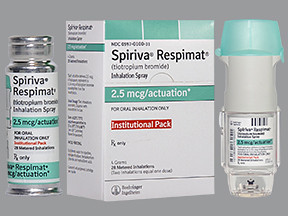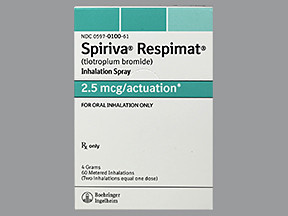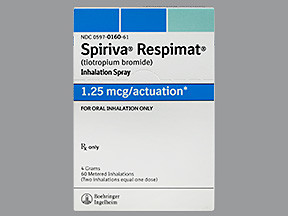TIOTROPIUM - INHALATION
PHONETIC PRONUNCIATION: (TYE-oh-TROE-pee-um)
COMMON BRAND NAME(S): Spiriva Respimat
GENERIC NAME(S): tiotropium bromide
Uses
USES: Tiotropium is used to treat lung diseases such as asthma and COPD (bronchitis, emphysema). It must be used regularly to prevent wheezing and shortness of breath. It works by relaxing the muscles around the airways so that they open up and you can breathe more easily. Tiotropium belongs to a class of drugs known as anticholinergics. Controlling symptoms of breathing problems can decrease time lost from work or school. This medication must be used regularly to be effective. It does not work right away and should not be used to relieve sudden breathing problems. If wheezing or sudden shortness of breath occurs, use your quick-relief inhaler (such as albuterol, also called salbutamol in some countries) as prescribed.
How to use TIOTROPIUM - INHALATION
HOW TO USE: Read the Patient Instruction Sheet for directions on the proper use of this medication. If you have any questions, consult your doctor or pharmacist. Follow the instructions for test sprays in the air if you are using the inhaler for the first time or if you have not used it for more than 3 days or for more than 21 days. Make sure to spray away from the face so that you do not get the medication into your eyes. A slow-moving mist is a sign that the inhaler is working properly. Inhale this medication by mouth as directed by your doctor, usually 2 sprays once daily. Do not inhale more than 2 sprays in 24 hours. Avoid getting this medication into your eyes. It may cause eye pain/irritation, temporary blurred vision, and other vision changes. Therefore, when using the inhaler, put your lips tightly around the mouthpiece. Rinse your mouth after using the inhaler to prevent dry mouth and throat irritation. If you are using other inhalers at the same time, wait at least 1 minute between the use of each medication. Use this medication regularly to get the most benefit from it. To help you remember, use it at the same time each day. Do not increase your dose or use this drug more often or for longer than prescribed. Your condition will not improve any faster, and your risk of side effects will increase. Clean the mouthpiece of the inhaler at least once a week as directed. When this medication is used to treat asthma, it may take 4 to 8 weeks before you get the full benefit of this drug. Learn which of your inhalers you should use every day and which you should use if your breathing suddenly worsens (quick-relief drugs). Ask your doctor ahead of time what you should do if you have new or worsening cough or shortness of breath, wheezing, increased sputum, waking up at night with trouble breathing, if you use your quick-relief inhaler more often, or if your quick-relief inhaler does not seem to be working well. Learn when you can treat sudden breathing problems by yourself and when you must get medical help right away. Tell your doctor if your symptoms do not improve or if they worsen.
Side Effects
Precautions
Interactions
Overdose
Images
Reviews
Faq for TIOTROPIUM - INHALATION
Tiotropium inhalation is used to treat chronic obstructive pulmonary disease (COPD), including chronic bronchitis and emphysema. It helps to improve breathing and reduce symptoms such as shortness of breath, wheezing, and cough.
Tiotropium inhalation comes in a special inhaler device. You should follow the instructions provided with the inhaler, but generally, you need to twist the cap off the inhaler, breathe out fully, place the mouthpiece in your mouth, and inhale the medication while pressing the dose-releasing button. Do not exhale into the inhaler mouthpiece and do not swallow the medication.
Common side effects of tiotropium inhalation may include dry mouth, constipation, blurred vision, and a fast or irregular heartbeat. Contact your healthcare provider if you experience severe side effects such as difficulty breathing, chest pain, or allergic reactions.
Tiotropium inhalation is not approved for use in asthma. It is specifically indicated for the treatment of COPD. If you have asthma, discuss appropriate treatment options with your healthcare provider.
If you miss a dose, take it as soon as you remember. However, if it is close to the time for your next dose, skip the missed dose and continue with your regular dosing schedule. Do not take a double dose to make up for a missed one.
Tiotropium inhalation is not recommended for use in children under the age of 6. It may be prescribed for children aged 6 to 17 years with COPD, but this should be determined by a healthcare professional.
- Tiotropium works by relaxing the muscles in the airways, which helps to open them up and ease breathing.
- Use tiotropium inhalation according to your doctor's instructions. Typically, it is inhaled once a day using a special inhaler device.
- Common side effects may include dry mouth, sore throat, cough, constipation, and urinary tract infection. If you experience any severe or persistent side effects, contact your doctor.
- It is recommended to consult with your doctor before using tiotropium inhalation during pregnancy or breastfeeding as it may not be safe for the baby.
- It is important to inform your doctor about all the medications you are taking, including prescription, over-the-counter, and herbal products, as they may interact with tiotropium inhalation.
- Tiotropium may start working within 30 minutes of inhalation, but it may take a few days to experience the full benefits. It is important to use it regularly as prescribed.
- No, it is important to continue using tiotropium inhalation as prescribed by your doctor, even if your symptoms improve. Stopping it abruptly may result in worsened symptoms.
- No, tiotropium inhalation is a prescription medication and is not available over-the-counter. You will need a doctor's prescription to obtain it.
Disclaimer
IMPORTANT: HOW TO USE THIS INFORMATION: This is a summary and does NOT have all possible information about this product. This information does not assure that this product is safe, effective, or appropriate for you. This information is not individual medical advice and does not substitute for the advice of your health care professional. Always ask your health care professional for complete information about this product and your specific health needs.



No Reviews Yet